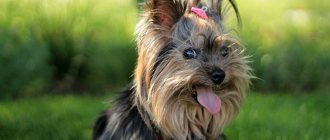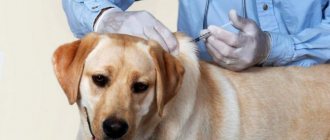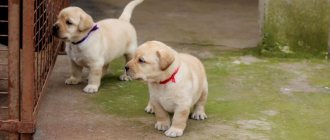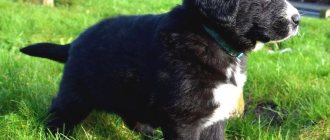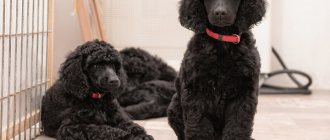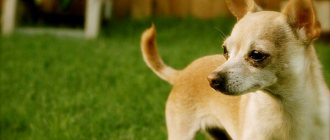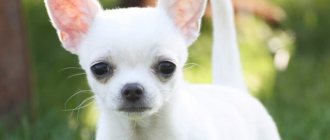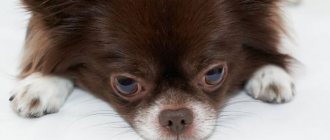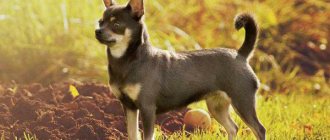Chihuahua standard
Chihuahua breed standard FCI-Standard N° 218 / 09.15.2010 / GB
BRIEF HISTORICAL SUMMARY: The Chihuahua is considered the smallest dog in the world and is named after the largest state of the Mexican Republic (Chihuahua). There is an assumption that these dogs lived in the wild, and during the Toltec civilization, they were domesticated. Images of a small dog called "Techichi" were used as decorations in urban architecture found in the city of Tula. These sculptures closely resemble real Chihuahuas .
TRANSLATION: K.Barbosov (source FCI-Standard N° 218 / 09/15/2010 / GB)
ORIGIN: Mexico. PUBLICATION DATE OF THE CURRENT OFFICIAL STANDARD: 07/29/2009 APPLICATION: Companion Dog CLASSIFICATION: Group 9 – Companion and Small Dogs Section 6 – Chihuahua No working tests
How to choose the right Chihuahua puppy: tips and advice from experts
In each specific case, you need to weigh the pros and cons. It often happens that an adult dog blends into the family so harmoniously that it becomes one with its new owner. However, if a dog is given away due to a difficult character or aggression, such an animal can only be adopted by a person who has experience in adjusting animal behavior.
One thing is for sure, every dog will definitely have the owner it deserves. And it very often happens that after the first dog, a second, third appears in the house...
We recommend reading:
Small dogs - what is the reason for poor appetite? The puppy bites. What to do? The dog doesn't stay home alone Biewer puppies
Head
Skull part:
Skull: Well rounded, apple-shaped (breed characteristic). Stop: Well defined, deep and wide, as the forehead is rounded and sits (“overhangs”) above the muzzle.
Front part:
Nose: any color is allowed. Moderately short, slightly upward. Eyes: Large, round, very expressive, not protruding, completely dark. Light eyes are acceptable, but not desirable.
Ears: Large, erect, wide open, wide at the base, gradually tapering to slightly rounded tips. At rest they are tilted at an angle of 45° .
Muzzle: Short, straight when viewed in profile, wide at the base, tapering towards the tip of the nose.
Lips: Dry and tight fitting. Cheeks: poorly developed, very clean. Jaws/Teeth: Scissor or level bite. Overshot, undershot, as well as any other anomaly in the position of the upper or lower jaw should be strictly punished.
Neck :
With a slightly pronounced scruff. Middle length. Thicker in males than in females. No suspension. In the long-haired variety, the presence of a “mane” is highly desirable.
Frame :
Compact and well balanced. Topline: horizontal. Withers: Slightly defined. Back: Short and strong. Loin: Very muscular. Croup: Broad and strong, almost straight or slightly sloping. Chest: Broad and deep, ribs well sprung. When viewed from the front, it is voluminous, but not extensive. When viewed from the side, it reaches the elbows. Not barrel-shaped. Underline and belly: Well defined, with a well-tucked belly. A sagging (weak) belly is acceptable, but not desirable.
Tail :
Set on high, straight, of medium length; wide at the base, gradually tapering towards the tip. The carriage of the tail is an important breed characteristic: when in motion it is carried either high, curved or in the shape of a semicircle with the tip directed towards the lumbar region, which gives balance to the body. The tail should never be carried between the hindquarters or below the line of the back. The hair on the tail depends on the coat variety and must correspond to it. In the long-haired variety, the hair on the tail forms a plume. When at rest, the tail is lowered and forms a small hook.
Where is the best place to buy
To choose a Chihuahua, you must first decide where the animal will be purchased. You should not make a choice in favor of pet stores and especially the market, since these places are dubious and the chances of purchasing a healthy pet are much lower. You should only buy a dog from specialized nurseries, but you shouldn’t let your guard down here either.
It is no secret that the cost of puppies of this breed is quite high, so some unscrupulous sellers, frankly speaking, abuse animals for the sake of profit. So, for example, they can save on dog food or use females as a machine for producing offspring, not allowing them to really recover from previous births. Naturally, in such conditions there is no need to even talk about healthy puppies.
To avoid encountering such sellers, pay attention to the conditions in which children are kept. The cage in which they are kept must be clean and the food must be of high quality. Also, a good breeder from whom you take a Chihuahua will always be able to provide you with all the necessary information about the pet’s pedigree, and even show you its parents if you want. The dog must have a veterinary passport with all the necessary data. In addition, the litter to which the puppy belongs must contain no more than five individuals. If everything is in order, feel free to purchase a pet.
Similar article: The most popular and rare colors of Chihuahuas
What to look for when purchasing
How to choose the right Chihuahua puppy? It is not enough just to find a good nursery where the baby will be purchased; you also need to know what indicators you should pay attention to when choosing.
External indicators
Let's start with the simplest thing - appearance. What do healthy dogs look like? Pedigree dogs should have an apple-shaped head, a short muzzle, and a prominent forehead. If the animal’s skull is flat, then it can be considered a defect. In addition, if the muzzle is too elongated or too flat, this is a clear indication that your baby is not purebred, and he had a terrier or Pekingese in his family.
We recommend this article:
Overview of the official types of the Chihuahua breed
Also, a healthy puppy will have clean and undamaged ears. It is necessary to carefully examine them for irritation or pustules if you do not want to purchase a sick animal. In addition, a wet nose indicates the healthy condition of the dog. If it is dry and hot, most likely the baby is sick or has a cold. The dog's eyes should also be free of any discharge. As a rule, they are huge, round and slightly moist.
Take a close look at the fur, it should be shiny and smooth. If your pet has long hair, then it should be soft and thick. Do not adopt a puppy that has any skin irritations or rashes. She must be absolutely healthy. Moreover, refuse to cooperate with the breeder if you find fleas in the baby’s fur - this is a clear indication of poor dog care.
Don't forget to feel the paws to eliminate the possibility of dislocations or improperly fused bones. Chihuahua puppies should be moderately well-fed: their weight should not be less than 0.5 kg and more than 2.5 kg. Even mini Chihuahuas cannot weigh less than half a kilogram. In general, upon examination, make sure that the puppies are absolutely healthy and do not have any congenital or acquired defects.
Similar article: What types of Chihuahua mestizos exist and what is characteristic of them?
Puppy bite
Another detail that will help you choose a healthy puppy is the bite.
With a correct bite, the upper jaw completely covers the lower jaw. In fact, if this animal has a correct bite at an early age, there is no guarantee that it will remain so ten years later. But if there are some problems at an early age, then over time the situation will only worsen.
Chihuahua behavior
The last important factor that helps determine whether a dog has health problems. She should be playful, active and friendly. If the puppy is apathetic or aggressive, this indicates abnormalities or illnesses. In addition, you should pay attention to the dog’s coordination – in healthy dogs everything is fine. Also pay attention to how the puppy eats: if he does it with appetite, then everything is fine; if not, it is quite possible that he has worms.
We recommend this article:
In which country did the Chihuahua dog breed originate?
Limbs:
Forelegs:
General appearance: The forelimbs are straight and parallel when viewed from the front. Vertical when viewed from the side. Shoulders: Smooth and moderately muscular. The angles of the humeroscapular joints are well defined. Elbows: Strong and close to the body, allowing free movement. Forearms: Straight and of good length. Pasterns: Slightly sloping, strong and flexible. Feet: Very small and oval, with well-spaced but not splayed toes (neither hare's nor cat's feet). The claws are well arched and moderately long. The pads are well developed and very elastic. Dewclaws are not desirable.
Hind limbs:
General appearance: The hind legs are muscular with long bones, vertical and parallel to each other, with good angulation of the hip, knee and hock joints, in harmony with the angulation of the forelegs. Metatarsals: hocks are short, with well-developed Achilles tendons; when viewed from behind, straight and vertical are well spaced from each other. Feet: Very small and oval, with well-spaced but not splayed toes (neither hare's nor cat's feet). The claws are well arched and moderately long. The pads are well developed and very elastic. Dewclaws are not desirable.
Movements:
The steps are long, elastic, energetic and active, with good reach of the front legs and drive of the hind legs. When viewed from behind, the hind legs should move almost parallel to each other, so that the tracks of the hind legs coincide with the tracks of the front ones. With increasing speed, there is a tendency for the center of gravity to shift (single step). The movements are stable, free and springy, without visible effort, the head is raised, the back is straight.
Leather:
Smooth and tight fitting throughout the body.
Puppy selection options
How to choose a Chihuahua to avoid annoying mistakes? When purchasing, you need to pay attention to the following factors:
External condition of the puppy . He should look neat, his skin and coat should be clean (with shine), his eyes and nose should be clear of discharge, and he should be moderately well-fed.
The behavior of a healthy puppy after rest is quite lively. It is possible to determine the puppy's health status by its habits: lethargy or aggressiveness is an undesirable sign.
Compliance with the breed standard . The breed standards must be a short muzzle length and a rounded skull shape.
The elongation of the muzzle indicates a relationship with that terrier, but if it is too short, the likelihood of a cross with a Pekingese is quite high.
The back in the stance is straight, the tail is not curved, slightly bent, but not curled into a ring. The puppy's forelimbs are straight.
At the rear, the angles of connection with the hip, knee and hock joints should be visible. At two months of age, this is quite difficult to determine, since this defect is more pronounced after five months.
Breed color
The standard acceptable colors for Chihuahuas are as follows:
- Black.
- Black and tan.
- Brindle.
- Chocolate.
- Ginger.
Black and tan Chihuahuas are characterized by the presence of bright spots, most often dark red in color. And all this beauty is on a black background.
The chocolate color of the Chihuahua implies a dark brown tint. Although there are two variations: chocolate and tan and chocolate tricolor.
Tiger representatives of the breed sport an unusual “fur coat”. Red, white and black colors alternate with each other. It looks quite original.
Photo gallery
These are quite loyal creatures, but when purchasing an adult Chihuahua, the owner will have to earn the dog’s trust.
Wool
There are two varieties in the breed:
Shorthair:
The coat is short and lies tightly all over the body. If there is an undercoat, the coat is somewhat longer; sparse hair on the throat and belly is allowed; slightly longer on the neck and tail, short on the head and ears. The coat is shiny and its texture is soft. Lack of wool is not allowed.
Longhair:
The coat should be fine and silky, smooth or slightly wavy. A not too thick undercoat is desirable. The coat is longer and forms feathers - on the ears, neck, on the back of the front and hind legs, on the paws and tail. Long flowing hair is not acceptable.
Color:
Any color is acceptable , with the exception of merle color.
Size and weight:
In the breed, only weight is taken into account, not height. Weight: Ideal weight: from 1.5 to 3 kilograms. Weight from 500 gr. up to 1.5 kg is acceptable. Dogs weighing less than 500 grams and more than 3 kg must be disqualified.
Chihuahua varieties by coat type
To understand what types of Chihuahuas exist, I suggest studying the international breed standard. The document was approved by the Russian Cynological Federation (abbreviated as RKF). Officially, it distinguishes two varieties of Chihuahua based on coat type:
- smooth-haired;
- long-haired.
The breed is striking in its abundance of coat colors. There are more than 100 different color variations. The rarest color is white (snow-white); unusual – brindle; disqualifying - merle.
Surprisingly, long-haired Chihuahuas shed less than their smooth-haired counterparts. It is impossible to determine the future coat type of a newborn puppy. The final formation of the structure and length of the coat takes up to 3 years.
Smooth-haired and long-haired Chihuahuas are the only
breed types mentioned by major kennel clubs. These include: AKC, FCI, RKF.
Temperament and appearance
The Mexican Chihuahua has always been famous for its tiny size and strong-willed character. It was revered in ancient times; it was believed that the dog drives away evil spirits and protects its owner. Like a guardian angel, the Chihuahua is still a constant companion of the entire female population, and children are crazy about Chihuahuas.
She attracts them with her comical nature, funny face, puny body and wit in her eyes. It is convenient to take dogs with you to work, on trips, moving, and on a walk it is convenient to carry them under your arm through puddles and obstacles. What can I say, the dog is comfortable in every sense. Is this how Chihuahuas like to live near people? Let’s find out.
In fact, a Chihuahua is happy with everything if you take care of it properly. She skates, frankly, like cheese in butter. The modern words from the song “Why are you so impudent” suit her perfectly. Why do you ask, because sneeze is so cute and tiny...
But its cuteness does not mean that the dog is calm; on the contrary, with a Chihuahua you are always like behind a stone wall; it, of course, will not be able to cripple an enemy, but it will be able to bark at your enemy or an evil passer-by with pleasure.
Not only does she have the temperament of a winner, but she also has selfish tendencies. So if strangers come to you, the dog will not trust them, it will growl and in every possible way will not allow contact with you until it understands that it is also loved and feels your affection. Take her in your arms when guests arrive, talk not only with the guests, but also with her, pet her and scratch her withers, the Chihuahua loves this very much.
However, if it is problematic for you to devote so much time to your Chihuahua, it is better to refuse to buy a puppy. A dog suffers greatly from loneliness, it can get sick and in general, when depressed, it will think that it is abandoned by everyone and forever. Depression in a Chihuahua can have disastrous consequences.
Additionally, Chihuahuas need care that you wouldn't give any other breed, or so they think. The upbringing and socialization of a Chihuahua comes first, since due to its belligerent nature and hot temper, it can find itself in a dead end situation or even harm its health, have an accident or be bitten by a big dog.
So, let's move on to the main thing where we started our conversation - how to choose a Chihuahua, how to choose the color and gender. And also how not to make a mistake when coming to the nursery and not choose a sick Chihuahua for yourself, read on.
He or she
Before choosing a pet, decide on the gender of the dog. Boys and girls Chihuahuas have their own characteristics. Boys have an active and curious character, while girls are more affectionate and cautious.
Owners of girls will have to deal with estrus and pregnancy. Unmated boys are calm towards females, but after mating it is best to lead the male on a leash - he will try to run after the girl during her heat.
Chihuahua boys also like to mark their territory. You will have to start raising him from the first day the boy appears in your home.
Flaws
Any deviation from the above points should be considered a fault, and the seriousness with which the fault should be regarded should be in exact proportion to its degree and its effect on the health and welfare of the dog. • Missing teeth. • “Double teeth” (preservation of temporary teeth). • pointed ears. • Short neck. • Long body. • Humped or sunken back (lordosis or kyphosis). • Beveled croup. • Narrow or flat chest. • Tail: incorrectly set, short or curled. • Short limbs. • Loose elbows. • Narrow set of hind legs.
at what age is it better to adopt a chihuahua puppy?
If you only know about Chihuas by hearsay, but have already become the happy owner of this little dog, here are some tips that will definitely come in handy.
1. If you want to buy a Chihuahua puppy, first check whether any of your household members are allergic to dog hair, also soberly assess your financial capabilities, then visit Chihuahua nurseries. A Chihuahua is an expensive dog that requires constant financial expenditure. Of course, later you will be able to more than recoup your costs by selling puppies. But first, be prepared for the fact that every visit to the veterinarian will cost you a pretty penny, and that if you feed your dog cheap food, it will have constant stomach problems. It is unlikely that you will be able to save money on keeping a dog of this breed. True, people who were able to purchase a Chihuahua say that they do not notice any financial expenses for its maintenance, since this dog compensates for all expenses with its love and affection for its owner.
2. When raising a Chihuahua, try to accustom your pet to a certain daily routine, and most importantly, to the same feeding time. This will be convenient for you and beneficial for the dog, since eating at the same time has a beneficial effect on the dog’s stomach and health. In addition, your dog will not be a beggar. Despite the fact that a Chihuahua usually drinks very little, there should always be clean water in its bowl, preferably boiled or natural mineral water without gases.
3. Give the Chihuahua a separate place to rest; a dog, like a person, can suffer from nervous and physical overload, and restful sleep is very important for it. It is best if the dog's rest area is located in the most remote place so that the dog is not distracted, and also protect the dog from cold and drafts. Don't forget to keep your dog warm after walks.
Girl or boy
Another question that often plagues people planning to buy a Chihuahua: is it a boy or a girl? Who is better? Whom to choose? In fact, both boy and girl Chihuahuas are both good, the difference is not too big.
If, thinking about who to choose, you have chosen a female Chihuahua, be prepared for the fact that she will be in heat twice a year. This continues for one to two weeks, and your pet may inadvertently stain your furniture. This problem can be solved with the help of special diapers or, if the individual is clean, she will take care of herself.
Another problem may be pregnancy and difficult childbirth, but if you do not plan to breed, just keep your pet from relationships with the opposite sex. In general, girls are clean, mark their territory much less, and are very easy to train.
Similar article: Description of the breed and everything about keeping the Parson Russell Terrier
With a boy, be prepared for fights with other dogs. In addition, male dogs often mark their territory, and this will either have to be weaned off or castrated. In addition, they are less willing to train than females, although at exhibitions the percentage of prizes for males is much higher. If you choose a male dog, you will need to put in more effort to get along with the dog. But for a person who loves animals, this should not be a big problem.
So, who should you choose - a boy or a girl? Weigh the pros and cons and choose someone you can get along with. After all, the main thing is to give your pet your love.
Features of the initial examination, requirements
Carry out a thorough initial examination of the animal. Even if you have documents, you need to be responsible when choosing a puppy and double-check everything yourself. These are the moments that are especially important.
- Wool quality. A healthy puppy's coat should be quite thick, smooth, and shiny. If it is faded, has bald patches, or falls out a lot, this definitely indicates insufficient care, some kind of developmental abnormalities or diseases.
- Temperament. The puppy must be active and playful. When there is obvious weakness and apathy, this should be alarming. Unfortunately, puppies sleep a lot, so their mood is difficult to assess. Try to observe them after waking up, while playing.
- Neurology. The dog must have good coordination. It is also advisable to check this during the game.
- Teeth. There should be no unpleasant odor from the mouth. It is worth checking the condition of your teeth immediately.
- Ticks, fleas. And this is possible, so you should take a closer look at the animal’s fur, as well as their bedding.
- Difficulty with digestion. If puppies defecate after eating, about 15 minutes later, this is a bad sign. Most likely, there are difficulties with digestion, or the puppies are infected with worms.
- Discharge from eyes, ears. It is purulent discharge and ulcers that indicate that the droppings are infected with some kind of infection.
Also take a closer look at how the puppies move, to see if they have any difficulties with their bones or joints. It is necessary to choose truly healthy, strong, viable dogs.
Disqualifying faults
• Aggressive or overly fearful. • Any dog clearly showing physical or behavioral abnormalities must be disqualified • Dogs with an open fontanel. • Cropped or short ears. • Deformed jaws. • Extremely long body. • No tail. • In the long-haired variety: dogs with very long, fine and flowing hair. • In the short-haired variety: baldness (alopecia). • Merle color. • Dogs weighing less than 500 grams. and more than 3 kg. NB: Males must have two apparently normal testes, fully descended into the scrotum.
- Post from 04/24/15
- National Chihuahua Breed Club
Basic moments
- The smallest dogs according to the Guinness Book of Records
- Dogs are very fragile, their bones break easily: they are handled with care and are not forced to climb or jump from high surfaces
- They have a cheerful disposition, are cheerful, active
- Due to their small size, bitches are often unable to give birth on their own: they undergo a caesarean section.
- Like all miniature breeds, Chihuahuas suffer from a Napoleon complex: they are not aware of their size and show aggression towards large dogs.
- They have a sense of their own superiority and are dominant: with a lack of upbringing they become aggressive and bully people and pets
- They love and obey all family members, but especially highlight the owner
- Adapt to any conditions: ready to walk for hours outside the city or sit in an apartment for days
- Physically and mentally formed by the age of one year
- Can't stand loneliness
- Ideal companions: always follow the owner and participate in all household chores
- Creepy owners: they can be jealous of the owner of other people and animals
Additional recommendations
When picking up a puppy from the nursery, you should definitely ask the breeders what diet is acceptable for the baby and what actions should be taken to ensure a more successful adaptation of the pet to the new family.
A radical change in diet can cause digestive system disorders, which can only be brought back to normal with medication.
Long-haired Chihuahuas have a friendlier character than short-haired ones. The latter are calmer and more balanced.
At what age is it better to adopt a puppy?
At what age is it better to adopt a puppy?
There is no single answer to this question. First of all, you should decide what you expect from the dog, how much time you are willing to devote to training the puppy. Start from this data. The pros and cons for each specific owner can be completely different. First of all, it is worth noting at what age it is definitely not worth adopting a puppy. This boundary mark is 45 days from the date of birth of the animal. Despite the fact that many puppies begin to feed themselves from 3 weeks of age, their mother continues to feed them milk until 1.5 -2 months of age. When breastfeeding, the puppy's immunity is stronger.
Immediately at 45 days, the puppies are certified, during which the owner of the kennel or a specialist from the dog club examines the puppies for breeding value and determines their exhibition prospects.
Puppies with malocclusion, kinked tails, cryptorchids, or color defects are excluded from the breeding program. However, these animals can make wonderful pets at a budget price. Such animals can be adopted after the first vaccination, which is done at 1.5 - 2 months + 7-10 days of quarantine. Babies of this age are already quite socialized, they have managed to receive maternal attention and the skills of being in a dog group among their littermates.
What you should pay attention to:
- the stomach of a small puppy is not capable of sudden and numerous changes in food, so it is advisable to feed the puppy in a new home according to the schedule to which he was accustomed in the breeder’s home. Don't forget to ask what kind of food your new family member is used to. If you are planning to introduce a new type of food, it is advisable to do it gradually, mixing it with what is already familiar. The quality of the new food should be no lower than what the puppy is used to. -the first days in a new home are stressful for the baby, try to provide the puppy with a limited space free of dangers -do not pour out your love like an avalanche, wait until the animal gets used to you -contact with other dogs can be carried out after all vaccinations have been completed
If your plans include exhibition activities and breeding, then the puppy you buy should be older. Since the correct bite of a puppy and the presence of all teeth does not guarantee that everything will be fine after the change. Closer to 7-8 months it is already possible to judge any prospects. It is impossible to guarantee a show career for a 2-month-old puppy. Of course, a mature puppy with show prospects is more expensive, but such an animal, as a rule, has already been trained, and this also costs time and money. Do not be afraid when you are offered the last puppy from the litter , while the rest of the babies have already been sold. A competent breeder sells the best puppies last, often not putting them up for sale at a young age.
The advantages of a grown puppy:
- the animal has a stable digestive system - the dog is less interested in small details on the floor - often such a puppy understands simple commands and knows its place in the house - you can immediately walk with the dog, since the vaccination and quarantine periods have been completed
To adopt or not to adopt an adult dog?
An adult dog is an established character.
Health problems
Little Chihuahuas should receive regular vaccinations. The first vaccinations are given by the breeder, which is reflected in the veterinary passport. Also, we must not forget to treat the animal from fleas, worms and ticks in a timely manner.
Miniature Chihuahuas are not the healthiest dogs. The smaller the size, the more health problems. They are prone to hydrocephalus and hypoglycemia. In the latter case, the dog often faints. If this happens, the animal needs to be shown to a veterinarian immediately. Glucose injections help relieve an attack.
And the owner should remember that the pet:
- Increased physical activity should not be given;
- a strict feeding regime is indicated (and food is divided into small portions);
- Sometimes you need to pour sweetened water.
Chihuahuas are prone to obesity, and excess weight can provoke bone diseases. Another common problem is tartar.
Tips from a dog handler
- If you want to immediately take part in exhibitions, you will probably ask at what age you can adopt a puppy. In this case, he should be 8–9 months old.
- Find out what your dog is fed. A sudden change in food can cause health problems.
- Long-haired Chihuahuas are more friendly.
- The dog's temperament will not change, so choose carefully.
- If you want to train a puppy, take one that closely follows the movements of your hands - these are more prone to training.
Breed Features
Let's talk about exterior features and character nuances.
The most important external feature of a Chihuahua puppy is its ears. Huge, widely spaced, they resemble locators.
Another distinctive feature is the wool. These dogs come in long-haired and short-haired varieties. The long coat curls beautifully at the bottom. The pet needs to be combed three to four times a week.
How to choose a Chihuahua puppy? Paying attention to character traits, first of all:
- Chihuahuas are very jealous. They get along with other pets, of course, but they will feel uncomfortable when doing so. It is better to take a representative of the breed as the only pet in the family.
- Dogs do not tolerate loneliness well. If the owner is constantly away from home, the baby will begin to get bored and waste away. Can get sick from loneliness.
- They are curious, they need everything and everything is interesting.
- It was already mentioned above that the Chihuahua is alien to cowardice. Getting into a fight with a large dog is no problem.
- They don't tolerate people raising their voices.
- With proper upbringing, they are restrained and silent, and will not bark over trifles.
Kinds
Today, the standard allows for 2 basic types of Chihuahuas, Deer and Cobby. Let's take a closer look at them.
1. Dir. In English this word is translated as “deer”. Indeed, such small dogs are very reminiscent of this proud forest animal. Their ears are set like deer antlers, high and parallel. Limbs are long and slender. The dog of this variety looks very presentable. Moves gracefully, without jerking.
2. Kobby. Compared to the dir, it is more clumsy, massive and heavy in terms of gait. The height of a cobby is approximately 2 cm less. But in strength, such a dog is superior to its closest brother. The main difference between cobby and dir is its large and pronounced head, similar to a large and ripe fruit. This dog has short but stable legs.
But that is not all. Chihuahuas are also divided depending on the length of their fur. They can be short-haired or long-haired. The main thing is that the animal’s fur is smooth to the touch, and when you look at it under the sun, it shines. In the second case, the standard allows for slight waviness.
Important! A representative of this breed cannot be curly.
Owner reviews
According to the owners of the Chihuahua, the appearance of such a dog in the house is akin to the birth of a small child. This breed requires careful and regular care, constant attention, good feeding and close health monitoring. But all this is worth the return that owners of small pets receive. They are funny, funny and smart. You won't get bored with them.
In general, the Chihuahua, according to numerous reviews, is a kind and grateful animal. And if you give this dog your attention, it will thank its owner with its love and devotion.
Interesting topics
- Papillon dogs - dwarf spaniels
- Description of the German Spitz dog breed
- Common breeds of small domestic dogs and recommendations for choosing them
- Shar Pei: breed characteristics and proper care
- Dalmatians are so popular in movies
- Features of the Japanese dog breed Shiba Inu
What do the varieties have in common?
Despite their size, build and coat length, absolutely all Chihuahuas make ideal pets and are suitable for keeping even in small apartments. All subtypes of these dogs are characterized by:
- intelligence and intelligence;
- devotion to the owner;
- affectionate disposition;
- courage.
Representatives of this breed do not require long walks and great physical activity, they do not require labor-intensive care and are suitable for people leading a sedentary lifestyle.
Character
Chihuahuas, despite their tiny size, are brave and resilient. They are distinguished by their devotion to their owners, intelligence and friendly attitude towards other animals and people. They are playful and affectionate pets that make wonderful companions.
If a Chihuahua is not raised correctly, it can grow up to be cocky, aggressive, cowardly or hysterical.
This happens especially often with overly caressed and spoiled dogs, which from an early age were allowed by loving owners to do whatever they wanted. This is why it is very important to understand that, despite its tiny size, the Chihuahua is a dog and that it too needs proper education and training.
Life of a Gnome
Inspired, we went home, joy knew no bounds. It was especially funny how the Gnome (that’s what we called him) comically wiped his butt on the carpet from a running start after pooping on his diaper. He sat on his butt and rode, moving his front paws. He fit in his shirt pocket and loved to sit there.
This was our first dog and we were not embarrassed that he was too smart for the age that the breeder told us. And some one is too skinny. However, he did not suffer from a lack of appetite, he became very attached to the family, and even when I turned away in bed, he pulled me by the ear so that I would turn to him and ticklishly lick my nose. He became very attached to my wife and me, we took him with us everywhere, because he didn’t want to stay at home even with the children, he always whined and yapped a lot.
This is how our week of doggy happiness passed. Friends came to visit us and we decided to go to a sushi bar. We decided not to take the gnome, otherwise we would not have been allowed into the establishment. He remained sitting in his nephew’s arms, the door closed, we left the entrance and began to wait for a taxi. And suddenly the daughter runs out in tears shouting: “The gnome is dead!”
Toilet training
Every living creature has a natural need to relieve itself. When keeping a Chihuahua at home, the owner should take care to provide a place where the dog can defecate with impunity. Place a tray with absorbent filling or diaper. Otherwise, feces and urine will end up in unexpected places in the apartment, for example, in the owner's shoe. Unexpected surprise?
The puppy should be toilet trained from the first days. There is no need to punish any mistake. You need to be restrained, not allow yourself to be assaulted, and not poke your puppy’s nose into the feces. Such actions will generate fear and apprehension and will worsen trusting relationships.
How to tell if a Chihuahua's fontanel is overgrown?
a fontanel in a Chihuahua using only a visual method.
, unless the soft spot is abnormally large. The veterinarian will determine the presence and size of the molera using an x-ray. You can independently determine the presence of a cranial foramen by light palpation (feeling) of the animal’s skull.
Interesting materials:
How to connect Google Authenticator? How to connect HTC Vive to laptop? How to connect Yandex Tilda card? How to connect Yandex maps to a website? How to connect Yandex navigator to an Android car? How to connect the game to steam? How to connect an X Box Van to a computer? How to connect an X Box Van to a laptop? How to connect an X Box Van? How to connect xbox?
Correct bite
Particular attention should be paid to the teeth and bite of your Chihuahua puppy. As a standard, at two months the puppy should already have twelve teeth (an equal number on the upper and lower jaws).
However, there are exceptions to the rules. An important parameter is the correct bite. This means that the upper jaw should completely cover the lower jaw.
But this does not ensure one hundred percent preservation of the correct bite in adulthood. But the initial malocclusion usually gets worse during the process of changing to molars.
Dogs with this defect are not allowed for breeding and do not take part in exhibitions. They are purchased only as a pet.
It is impossible to determine in advance whether a dog’s bite is correct; this is the specificity of the Chihuahua breed.
Height and weight of the puppy. The largest puppy from the litter may eventually become no larger than its brothers. Likewise, large parents sometimes give birth to mini Chihuahuas.
Before purchasing a Chihuahua puppy, you should still familiarize yourself with its pedigree. When studying genealogy, the main interest is in the uniformity of the line.
The uniformity of the line confirms the correct culling of dogs that did not meet the requirements of the breed standard. This indicator is especially important for future exhibition participants.
The length of the body is slightly greater than the height at the withers. However, an almost square format is preferred, especially in males. In females, a more extended format is acceptable, due to reproductive function.
Tricks you shouldn't fall for
Not all breeders behave correctly. This is understandable: their main task is to sell puppies. So before buying a Chihuahua dog, you need to find out what tricks they use:
- Do not think that from three months you can participate in exhibitions. No matter what the owner says, you can start at eight.
- Don’t believe that a dog’s temperament will change with age; a Chihuahua’s character is stable.
- The breeder cannot justify the external differences of the dog by its foreign origin.
- There is no point in purchasing a Chihuahua without a pedigree or birth certificate; only with them can you prove the breed of the animal.
- Discounts for registering an animal without documents indicate the seller’s dishonesty.
- Contrary to some theses, puppies cannot be sold under the age of 45 days after birth.
These tricks cause people to purchase puppies that are unhealthy or not ready to go. In the future they may well grow into nervous or sickly dogs. Be aware of how unscrupulous breeders behave, and then you and your future dog will not become their victims.
Water treatments
It is enough to wash your Chihuahua with specialized shampoo once a quarter for hygienic purposes. Human shampoo is not suitable because... it can strip your dog's skin of essential oils, leading to hair loss, dryness and brittleness! You can bathe without shampoo more often if the dog likes water treatments, but without enthusiasm, no more than once every 2 weeks.
The water should be warm, optimal temperature: 35-40°C. It is important to ensure that water does not get into your ears. At the end of the procedure, wipe the dog's fur dry with a clean and warm cotton towel, or use a hairdryer.
Weight table by month
The most reliable and accurate forecast of how much a pet should weigh can be given by its pedigree. Size, like some other parameters, is inherited. But to determine the approximate weight, you can use the weight table for Chihuahuas.
| Age/Weight of the newborn, gr. | 70 | 80 | 85 | 100 | 110 | 120 | 130 | 145 | 155 |
| 1 Week | 106 | 113 | 142 | 156 | 184 | 198 | 227 | 255 | 269 |
| 4 weeks (1 month) | 198 | 227 | 269 | 312 | 369 | 452 | 482 | 539 | 595 |
| 8 weeks (2 months) | 312 | 369 | 454 | 539 | 610 | 680 | 765 | 822 | 936 |
| 12 weeks (3 months) | 425 | 539 | 624 | 737 | 851 | 936 | 1049 | 1162 | 1276 |
| 16 weeks (4 months) | 567 | 709 | 851 | 964 | 1106 | 1247 | 1389 | 1531 | 1673 |
| 20 weeks (5 months) | 680 | 851 | 992 | 1162 | 1304 | 1474 | 1644 | 1814 | 1985 |
| 25 weeks (6 months) | 765 | 946 | 1134 | 1332 | 1503 | 1701 | 1899 | 2070 | 2269 |
| 18 months | 908 | 1135 | 1362 | 1589 | 1816 | 2043 | 2270 | 2497 | 2724 |
To read: Pug: a loyal friend and a cheerful glutton. Description of the breed, advantages and disadvantages
Estimated weight by one and a half years at a weight of 2 months:
| Weight at 2 months | Final weight of an adult dog |
| 0.30 kg | 0.90 kg |
| 0.36 kg | 1.15 kg |
| 0.45 kg | 1.35 kg |
| 0.55 kg | 1.60 kg |
| 0.60 kg | 1.80 kg |
| 0.70 kg | 2.05 kg |
| 0.76 kg | 2.25 kg |
| 0.93 kg | 2.71 kg |
| 1.10 kg | 3.18 kg |
